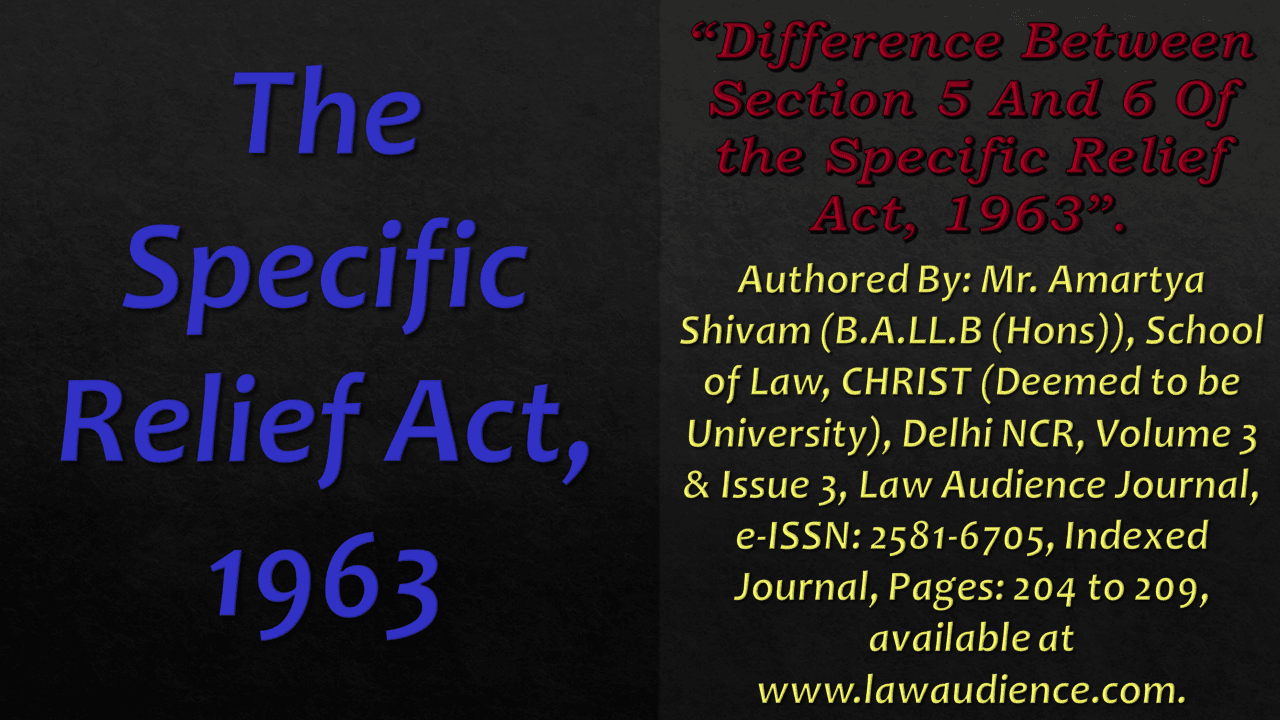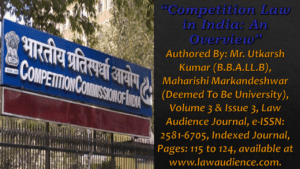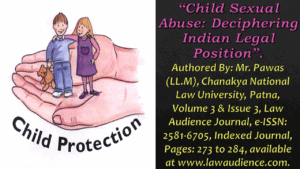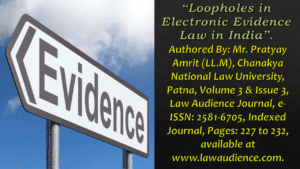Click here to download the full paper (PDF)
Authored By: Mr. Amartya Shivam (B.A.LL.B (Hons)), School of
Law, CHRIST (Deemed to be University), Delhi NCR,
Click here for Copyright Policy.
SECTION 5 OF THE SPECIFIC RELIEF ACT, 1963:
This section discusses how particular immovable property may be recovered.
It reads as “A person entitled to the possession of the specific immovable property can recover it in the manner provided by the Code of Civil Procedure, 1908”.
The main point of this section is ‘title,’ which means that whoever has a superior title is entitled to ownership. It’s possible that the title is one of ownership or possession.
I. POSSESSION IN THE LEGAL TERMS:
Possession has been defined by jurists depending on their personal ideas. According to Salmond, it is the most basic contact between man and objects. Henry Maine, on the other hand, characterized it as “engagement with a thing that excludes other people from appreciating it.” According to Federick Pollock, a man is deemed to possess anything over which he seems to have control or power to exclude others. Custody or control are synonyms for possession. The concept of ownership evolved slowly as society progressed. Possession, according to Salmond, forms the bond between men and their possessions. It’s a simple fact. Possession, according to Pollock, is having bodily control over something. Possession, according to Savigny, is the bodily power of exclusion. Possession protection is a subset of personal protection. The protection of possession is based on the freedom of volition.
Possession, according to Ihering, is the de facto exercise of a claim over a thing. Possession, according to Roman law, is prima facie proof of ownership. It backs up the ownership title. The owner of an item is assumed to be the person who has it. Long-term use of a property results in ownership. This is referred to as prescription, and possession is defined in nine points of law.
II. OWNERSHIP IN THE LEGAL TERM:
According to Austin, ownership is a legal right that protects anybody who is subject to a law that grants the right to provide anything to an indefinite user. It is a right in rem that the owner has against the rest of the world. It encompasses both material and intangible possessions. The former is used to describe real things, whereas the latter is used to describe all claims. Ownership, according to Hebert, is a broad right in rem. Holland ownership refers to having complete control over a thing. The relationship between a person and any vested right, as well as an item that forms the subject matter of his possession, according to Salmond. The relationship between a person and the right that is vested in him is referred to as ownership. The right to a thing is the only thing that can be possessed. To put it another way, a thing cannot be owned, but a right over it can. Jurists have defined ownership in a number of ways. They all agree, however, that ownership is the broadest and most powerful right one can have over anything. Ownership, according to Hibbert, involves four categories of rights:
- The right to make use of something.
- The right to prohibit the object from being used by others.
- The power to destroy it.
Example for Section 5:
Even though Kamal lives on rent in a bunglow, he has the right to sue anybody who has forcefully evicted him, since he has possession of the property. Given the above, one would wonder whether a person with no title might file an action for recovery of possession and ejectment of a trespasser, as well as seek an injunction against the trespasser, based only on possessory title. Before addressing this problem, it is necessary to first comprehend the Indian idea of “possessory title.”
The “Hon’ble Supreme Court in a case titled Poona Ram vs. Moti Ram & others” [1] wherein The Court defined possessory title to a specific property as such when a person is in settled or established possession of the property while discussing the law on possession and ownership of immovable property.
The distinction between a possessory and a proprietary title is defined by Indian law. According to Article 65 of Schedule I of the Limitation Act of 1963, an aggrieved person has 12 years to commence a claim for recovery of possession of immovable property or any interest therein based on proprietary title. After 12 years of continuous possession, a person is considered to have perfected his claim to the property by adverse possession if he can demonstrate that his possession was peaceful, open, and continuous.[2] The limitation act also states that if no suit is filed within the 12-year period specified in Article 65, the person’s right to file a suit for possession recovery is forfeited. The practical impact is the extinction of the owner’s title in favour of the person in possession, who now has an absolute interest in the property. The Privy Council established this concept in the case “Gunga Govind Mundal and others vs. The Collector of the Twenty-Four Pergunnahs and others[3].”
III. SECTION 6, SPECIFIC RELIEF ACT:
“(1) If any person is dispossessed without his consent of immovable property otherwise than in due course of law, he or any person claiming through him, may by suit recover possession thereof.
(2) No suit under this section shall be brought-
After the expiry of six months from the date of dispossession.
Against the Government.
(3) No appeal shall lie from any order or decree passed in any suit instituted under this section, nor shall any review of the decree under this section is allowed.
(4) Nothing in this section shall bar any person from suit to establish his title to such property and to recover possession thereof.”
In the meaning of section 6, possession refers to legal possession that may exist with or without physical possession and can be of any legitimate origin. In a section 6 lawsuit, the plaintiff is not required to demonstrate title. Long-term peaceful possession suffices to establish real possession. After the lease agreement expires, the tenant retains legal possession and cannot be evicted until the owner obtains an eviction order against him, according to K.K. Verma vs. Union of India.[4] Section 6 of the Specific Relief Act of 1963 gives a remedy to a person who is dispossessed of an immovable property without his permission and may institute a claim for recovery of possession despite any other title that may be shown in such suit. As a result, no one is allowed to take property by force; instead, they must seek control via the court system.
The Division Bench, which consisted of three learned Judges, held that a true owner has the right to evict or throw out a trespasser while he is in the act or process of trespassing, but that this right is not available to the true owner if the trespasser has successfully completed his possession to the true owner’s knowledge. In such cases, the law compels the genuine owner to evict the trespasser using the legal remedies available to him or her.[5]
IV. DIFFERENCE:
The Civil Method Code, 1908 (hereafter referred to as “CPC”) outlines the procedure for reclaiming specified immovable property. As a result, Section 5 deals with the recovery of immovable property based on title, which might be either ownership or possessory. An action under Section 5 SRA, read with Articles 64 and 65 of the Limitation Act, 1963, may be launched. When a complaint is brought under Section 5 of the SRA and Article 65 of the Limitation Act, the plaintiff must assert his title to the property, which might be either ownership or possessory. The right to own immovable property and the deprivation of that right are therefore the causes of action in a suit brought under Article 65. In such circumstances, the defendant may always show his own superior title, if one exists.
In such cases, the time of imitation is 12 years from the day when the plaintiff’s ownership of the immovable property becomes unfavorable. According to “Section 27 of the Limitation Act,” if a suit is not filed within the stipulated period of 12 years from the date of reckoning, the party claiming entitlement to the property loses its title to the property due to adverse possession, and thus the right to claim back the property becomes extinct.[6] Adverse possession must be separated from permitted possession; therefore, the traditional conditions of adverse possession, namely hostile, and continuous, must be shown, as has been ruled in numerous judgments showing “Kaloo Singh vs. Raghunath Singh[7].”
In a suit brought under “Section 5 read with Article 64 of the Limitation Act”, the cause of action is (i) settled possession and (ii) subsequent dispossession, and in such a case, the plaintiff cannot raise the issue of his title; rather, the defendant may raise the issue of title qua the immovable property in his defence, and if the defendant does, the plaintiff can then go on to prove his own better title over the property. In such circumstances, the statute of limitations is 12 years from the date of repossession. As a result, Section 5 specifies a normal action brought under Section 9 CPC in conjunction with some other substantive regulation, as well as “Articles 64 and 65 of the Limitation Act”.[8]
Section 6 is, on the other hand, a summary lawsuit. In contrast to Section 5, it offers an alternative remedy in which the person who has been evicted may reclaim ownership by demonstrating prior possession and subsequent unjust eviction. In such instances, no evidence of title against the occupier is acceptable since the provision’s only purpose is to avoid eviction. However, Section 6(4) states that the individual who is the subject of a Section 6(1) decision may seek to establish title and regain possession later.
The plaintiff must establish animus (intention to utilise the property) and corpus for established possession (control over property). In such circumstances, the statute of limitations is 6 months from the date of improper possession. The Supreme Court has reaffirmed in Jaswant Singh vs. Punjab Agricultural University,[9] that rulings under Section 6 SRA are summary in nature and hence not susceptible to appeal.
V. CONCLUSION:
“Section 5 of the Code of Civil procedure” allows for the recovery of possession based on right to possession, and it may be done via the procedure provided by the “Code of Civil Procedure, 1908”. Ownership or tenancy may be the foundation for entitlement. To get possessory rights, you do not have to be the legal owner. A valid renter has the same right to possession as a legal owner.
Plaintiff must establish settled possession and dispossession in an action brought under this clause in conjunction with “Article 64 of the Limitation Act”. If a person seeks possession only on the basis of ownership, this clause might be interpreted in conjunction with “Article 65 of the Limitation Act.” The statute of limitations has been shortened to twelve years from the date of eviction.
On the other hand, Section 6 is a prompt remedy established to prevent individuals from taking law into their own hands. Section 6 allows for possession to be reclaimed if it was taken illegally. This article lays forth a fundamental need for a plaintiff: he must show that he was in possession of a property and that he was unjustly taken from it, with the caveat that the claim must be filed within six months after dispossession and that it cannot be made against the government.[10]
This clause was significantly changed in 2018, with the addition of the phrases “through whom he has been in possession.” It has broadened the scope of this rule by allowing the owner to sue if his renter is illegally evicted from the premises. Plaintiff, on the other hand, cannot regain possession on the basis of title in a matter filed under section 6. Following the restoration of possession under Section 6, the party may establish title in a future action under Section 5.
Cite this article as:
Mr. Amartya Shivam, “Difference Between Section 5 And 6 Of the Specific Relief Act, 1963”, Vol.3 & Issue 3, Law Audience Journal (e-ISSN: 2581-6705), Pages 204 to 209 (25th January 2022), available at https://www.lawaudience.com/difference-between-section-5-and-6-of-the-specific-relief-act-1963/.
Footnotes & References:
[1] Poona Ram v. Moti Ram & others (Civil Appeal No. 4527 of 2009).
[2] Athana, “Recovery of Possession of movable and immovable property,” BLOG, Ipleaders.
[3] Gunga Govind Mundal and others v. The Collector of the Twenty-Four Pergunnahs and others, 11 M.I.A. 212.
[4] K.K. Verma v Union of India, AIR 1954 Bom 358.
[5] Ram Rattan v. State of Uttar Pradesh, 1977 AIR 619.
[6] “Understanding the concept and procedure of recovering of possession of immovable property,” Blog, Ipleaders.
[7] Kaloo Singh v. Raghunath Singh, Appeal 1143/2018.
[8] “Possession of immovable property on date of dispossession is sine qua non for relief under Section 6 of Specific relief act; investigation into title irrelevant,” SCConline.
[9] Jaswant Singh v. Punjab Agricultural University, SLP, 24044/2018.
[10] “Law Respects possession- understanding the concept of adverse possession,” MONDAQ.



